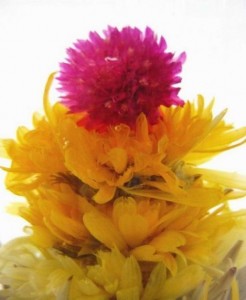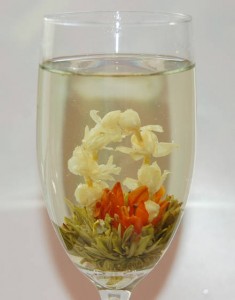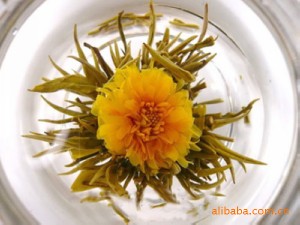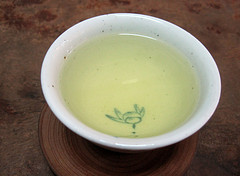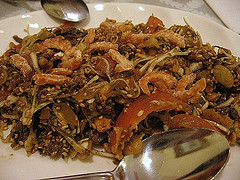
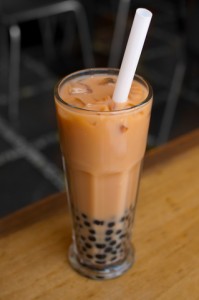
Bubble tea may be a new and novel idea for some people. While not common here in Australia, it can be found at many tea stands, especially those featuring Asian teas and drinks. Usually served cold, it contains rather large tapioca balls and is enjoyed through a very large, wide straw. Having spent many years in Taiwan, where Bubble tea originated, my kids and I enjoyed it on a regular basis—especially during the hot, muggy days of summer. It is a fairly new drink, having first been served in the 1980’s. Claims of who first made the tea are made by two different tea houses in Taiwan and to date I do not believe either has been successful in proving they came up with the original Bubble tea recipe.
Green, Red or Black Tea Base
As the name implies, it is usually made from freshly brewed tea –either green tea or black tea though these days there are quite a few variations on the original recipe. In fact, when first made it was served hot rather than cold. Milk and either tapioca balls or candied taro are added to the tea. You can also buy it with small, hard jelly cubes added. Fruit flavours are often added to the teas as well. Like I said, there are many different variations available and most tea houses will strive to come up with something unique to their particular shop.
A Bubble Tea By Any Other Name is Still Bubble Tea
You may find it called a number of different names including foam milk tea, pearl tea or Boba tea. Most people, at least here in Australia, simply ask for Bubble tea. Tea containing large sized tapioca balls is by far the most commonly served. Incidentally, it was not named Bubble Tea because of the tapioca balls; which is what I originally thought. The tea is usually made in a large disposable cup and sealed tightly over the top with plastic. Before serving, it is shaken quite vigorously which results in a thick top layer of foam – and that is why it is called ‘Bubble Tea’.
Home Made Bubble Tea
If you like to experiment with making different teas, you may find it fun to make your own Bubble tea. It is really not very difficult to do, and in order to make it even easier, it is possible to buy “Bubble tea” kits online that are shipped complete with the right kind of tapioca and even a specific tea mix.
With a little ingenuity and shopping around you can also find the ingredients here in Australia fairly easily. While using a kit to make it may be simple, you will find that you can experiment much more if you search out the ingredients and make it yourself. Whether you purchase an online kit or buy the separate ingredients yourself, your main challenge will be cooking the tapioca so it is just right. (“Just right” can be somewhat subjective, though most Bubble Tea enthusiasts agree that the tapioca should not be overcooked, nor should it be too chewy! As I said, while it is very subjective, people will often return to the same tea shop or tea stand time after time in order to buy tea with tapioca that is, to their taste, perfect.)
Bubble Tea Ingredients
First off, track down a local Asian store of which there are usually one or two in most of larger shopping centres, and look for some large tapioca balls (1/4 inch tapioca). If you do not see them on the shelves you should ask if they are available. If not, they will probably be able to tell you where you can find them. You may also find some stores stock a tea mix or tea blend that is specifically made for Bubble tea. You may want to try it, but it is not essential. You should also buy the large sized straws as well – remember the straws need to be large enough for those ¼ inch tapioca balls to fit through.
It is possible to buy these ingredients online, on eBay for example, however I could only see white tapioca balls and not the usual black coloured tapioca. Other online stores sell it also, but you need to buy quite a large quantity – something you may not want to do if you simply want to try it out first.
The other ingredients can be bought in any supermarket. You will need:
– Sugar or fructose syrup
– Tea – preferably loose leaf tea. As mentioned above you can use green tea, read tea, black tea or even oolong tea. If you can’t find loose leaf tea a teabag will suffice.
– Dairy creamer, milk or cream
– A cocktail shaker
Now, Onto the Bubble Tea Recipe
Here is a very basic Bubble tea recipe you can start off with. Once you are more adept at making it and you know exactly how long to cook the tapioca balls for, you may have fun experimenting with different recipes.
¾ cup of tea for each Bubble tea you serve
milk, cream or dairy creamer
ice cubes
¼ cup of cooked tapioca per serving
syrup—either fructose syrup or syrup made from dissolving sugar in boiling water.
Using the cocktail shaker, first of all shake together the brewed tea, milk and syrup till it is all mixed together.
Add your ice cubes to the shaker and shake until you see froth on top.
Add the tapioca balls into the tall serving glass and pour the tea into the glass.
Place the large straw in each glass, and serve.
Variations to the Bubble Tea Recipe
As mentioned above, there are quite a few variations to this recipe.
* First, try using different teas. You may find fruit teas are quite tasty. Some people enjoy Bubble tea made with ginger tea or with ginger flavoured loose leaf tea.
* For a slightly different taste, try using evaporated milk instead of regular milk or creamer.
* Finally, see if you can find some candied taro balls or small cubes as a substitute or make agar-agar squares.
Footnote: Cooking Perfect Tapioca
This is the most important step in making Bubble tea—properly cooked tapioca! While hard to explain the texture it should be, in essence it should not be too hard and chewy but not too soft or jelly like either. Of course, it will take longer to cook the larger sized balls of tapioca than it does regular minute dessert tapioca.
You should generally allow 8 cups of water per cup of tapioca balls and make sure the pot you use for cooking the tapioca is large as the tapioca expands quite a lot while cooking. Boil the water first and then add the tapioca to the boiling water. If the balls seem to be stuck together you may want to stir the mix to separate them. One way to tell that they are separated is if the tapioca begins to rise to the top of the boiling water. Boil for 20 to 25 minutes, turn off the hot plate and let the pot sit for twenty minutes more.
When ready, you can pour the tapioca balls into a strainer and then rinse them with barely warm water. Stir in some fructose or syrup—this helps to keep the tapioca balls separate. It is recommended that you cook only what you are planning on using as cooked tapioca should not be stored in the refrigerator – this ruins the consistency of the balls. You can apparently store them in a Ziploc bag, flatten them out and freeze them. When unfreezing, you simply put the frozen tapioca balls into already boiling water and boil for a few minutes.
Is it Worth The Effort?
Yes, it does take a bit of effort to make Bubble tea. First you have to track down the ingredients and then it takes time to boil the tapioca. The main advantage to making it yourself is that you can tailor your recipe to your particular taste, you can experiment with different ingredients and you don’t have to go out to enjoy it. It also is a fantastic drink to serve to visitors on a hot day and quite a good conversation starter especially if served to people who have never tried it before.
